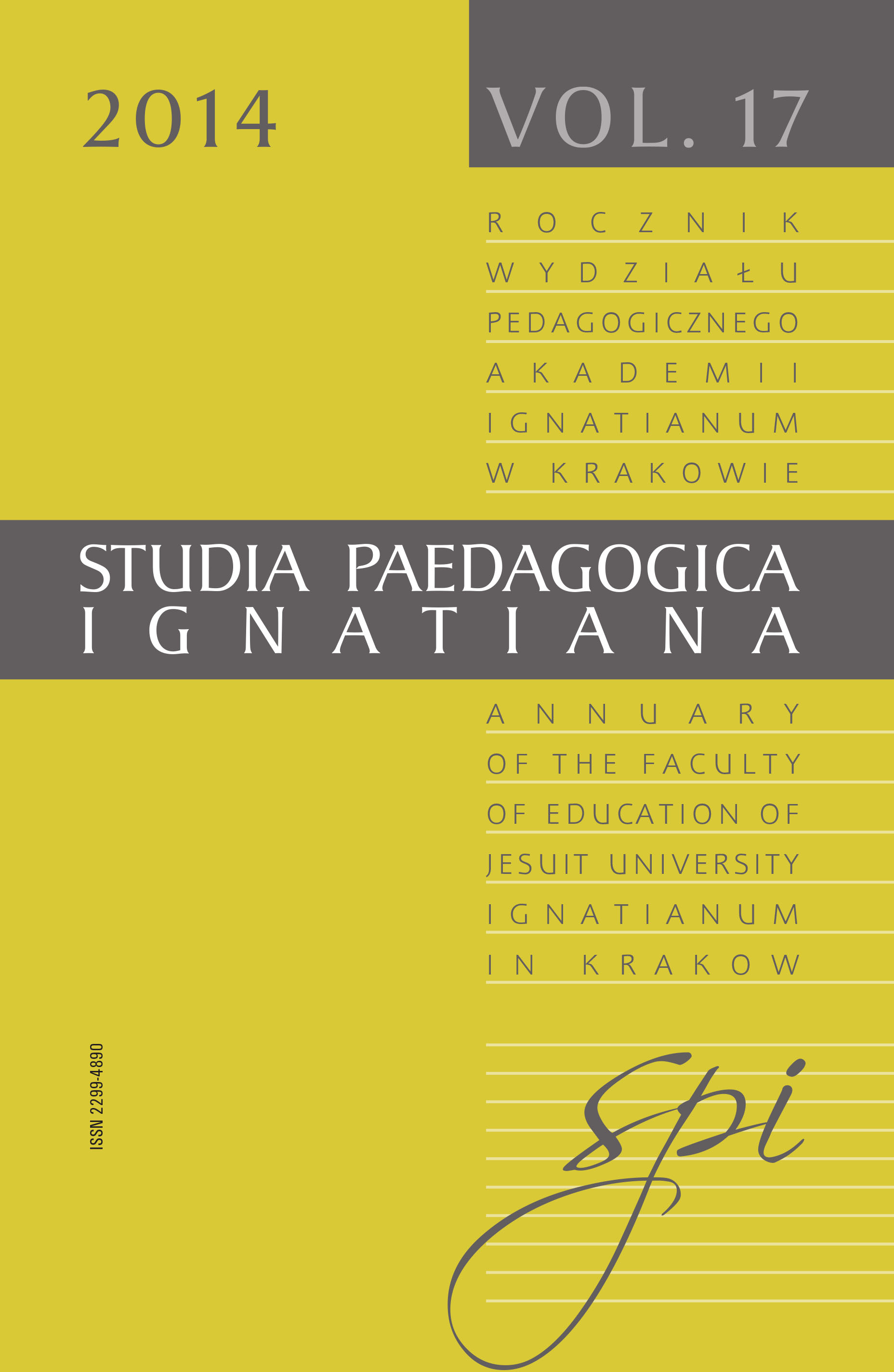Zróżnicowanie form i stopnia patologicznych zachowań młodzieży w środowisku szkolnym. Analiza porównawcza na przykładzie młodzieży objętej resocjalizacją zakładową – raport z badań
DOI:
https://doi.org/10.12775/SPI.2014.010Słowa kluczowe
młodzież, przestępczość nieletnich, resocjalizacja, środowisko szkolne, patologiczne zachowaniaAbstrakt
W świetle badań empirycznych w Polsce ujawniają się trzy główne tendencje w przestępczości nieletnich, które wyraźnie korelują z tendencjami ogólnie obserwowanymi od kilkunastu lat w skali globalnej. Widzimy systematyczny i znaczący ilościowy wzrost ogólnych rozmiarów wszystkich rodzajów przestępczości. Obniżeniu uległa dolna granica wiekowa nieletnich przestępców (w tym znaczny wzrost liczby przestępstw, których sprawcami są nieletni poniżej 13. roku życia). Coraz częściej rejestrowane są też poważne przestępstwa dokonywane przez kilkuletnie dzieci. Wreszcie notuje się nagły wzrost przestępstw gwałtownych, opartych na agresji i przemocy skierowanej zarówno na rówieśników, jak i osoby dorosłe. Podjęte przez autora niniejszej pracy badania diagnostyczno-eksploracyjne sprowadzają się do pytania: W jakim stopniu różnicowanie zakładów na zamknięte, półotwarte i otwarte odpowiada różnicowaniu młodzieży przebywającej w tych zakładach w kontekście różnych zmiennych środowiska szkolnego, z którego się ona wywodzi? Przedmiotem niniejszego studium jest młodzież objęta oddziaływaniami resocjalizacyjnymi i terapeutycznymi. Zaprezentowane badania o charakterze empirycznym analizują środowisko szkolne młodzieży społecznie niedostosowanej. Analizie poddano różne formy patologicznych zachowań młodzieży w środowisku szkolnym. Badania ukazują złożoność różnych czynników szkolnych wpływających na przestępczość nieletnich. Rozpatrując zmienne środowiska szkolnego, które w różnym stopniu i w różny sposób charakteryzują i różnicują badaną młodzież, należy pamiętać także o silnym wpływie czynników rodzinnych, rówieśniczych, kulturowych i światopoglądowych, które w sposób istotny oddziaływają na młodzież, co potwierdzają liczne badania porównawcze. W świetle przeprowadzonych badań raz jeszcze należy podkreślić, że żadne formy patologii społecznej z udziałem nieletnich nie mogą zostać pozostawione samym sobie.
Bibliografia
Błachut J., A. Gaberle, K. Krajewski, Kryminologia, Wydawnictwo „Arche”, Gdańsk 2004.
Brzeziński J., Badania eksperymentalne w psychologii i pedagogice, „Scholar”, Warszawa 2000.
Brzeziński J., Metodologia badań psychologicznych, Wydawnictwo Naukowe PWN, Warszawa 2005.
Fagan J., T.R. Tyler, Legal Socialization of Children and Adolescents, „Social Justice Research” 2005, t. 18, nr 3.
Guerra N.G., L.R. Huesmann, A. Spindler, Community Violence Exposure, Social Cognition, and Aggression Among Urban Elementary School Children, „Child Development” 2003, t. 74, nr 5.
Howard K.A.S., S.L. Budge, K.M. McKay, Youth Exposed to Violence: The Role of Protective Factors, „Journal of Community Psychology” 2010, t. 38.
Jurjewicz H., Religious-Acculturational and Cultural-Integrating Dimension of the Polish Pastoral Care in the United States of America, „Społeczeństwo, Kultura, Wartości” 2013, nr 5.
Ledingham J.E., A. Younger, A. Schwartzman, G. Bergeron, Agreement Among Teacher, Peer, and Self-Ratings of Children’s Aggression, Withdrawal, and Likability, „Journal of Abnormal Child Psychology” 1982, t. 10, nr 3.
Lipsey M.W., J.H. Derzon, Predictors of Violent or Serious Delinquency in Adolescence and Early Adulthood: A Synthesis of Longitudinal Research, w: Serious and Violent Juvenile Offenders: Risk Factors and Successful Iterventions, red. R. Loeber, D.P. Farrington, Sage Publications, Thousand Oaks 1998.
Mościcka L., Przestępczość nieletnich. Podłoże, geneza, motywy, Zakład Narodowy im. Ossolińskich, Wrocław 1970.
Nowak S., Metodologia badań socjologicznych, PWN, Warszawa 1970.
Pindera M., Współdziałanie rodziców i nauczycieli w procesie wychowania dzieci, w: Trójpodmiotowość w praktyce edukacyjnej szkoły zreformowanej, red. K. Misiołek, Górnośląska Wyższa Szkoła Pedagogiczna, Mysłowice 2002.
Proctor L.J., Children Growing up in a Violent Community: The Role of the Family, „Aggression and Violent Behavior” 2006, t. 11, nr 6.
Pytka L., T. Zacharuk, Wielowymiarowa geneza zaburzeń przystosowania społecznego, w: Pedagogika społeczna, red. T. Pilch, I. Lepalczyk, Wydawnictwo „Żak”, Warszawa 1995.
Radziwiłł A., O współdziałaniu między szkołą a domem, WSiP, Warszawa 1974.
Rogala S., Psychologiczne, determinanty współdziałania rodziców i nauczycieli, Instytut Śląski, Opole 1983.
Schwartz D., L.J. Proctor, Community Violence Exposure and Children’s Social Adjustment in the School Peer Group: The Mediating Roles of Emotion Regulation and Social Cognition, „Journal of Consulting and Clinical Psychology” 2000, t. 68, nr 4.
Spionek H., Zaburzenia rozwoju uczniów a niepowodzenia szkolne, PWN, Warszawa 1981.
Sztumski J., Wstęp do metod i technik badań społecznych, Wydawnictwo UŚ, Katowice 1999.
Szyndler M., M. Wilczek, Rola autorytetów w relacjach nauczyciel – uczeń, w: Trójpodmiotowość w praktyce edukacyjnej szkoły zreformowanej, red. K. Misiołek, Górnośląska Wyższa Szkoła Pedagogiczna, Mysłowice 2002.
Urban B., Zaburzenia w zachowaniu i przestępczość młodzieży, Wydawnictwo UJ, Kraków 2002.
Wilson S.J., M.W. Lipsey, School-Based Interventions for Aggressive and Disruptive Behavior: Update of a Meta-Analysis, „American Journal of Preventive Medicine” 2007, t. 33, nr 2.
Pobrania
Opublikowane
Jak cytować
Numer
Dział
Licencja
Autor zgłaszając swój artykuł oświadcza, że:
jest Autorem artykułu (zwanego dalej Utworem) i:
- przysługują mu wyłączne i nieograniczone prawa autorskie do Utworu,
- jest uprawniony/a do rozporządzania prawami autorskimi do Utworu.
Udziela Uniwersytetowi Ignatianum w Krakowie nieodpłatnej, niewyłącznej, nieograniczonej terytorialnie licencji do korzystania z Utworu na następujących polach eksploatacji:
- utrwalania utworu w formie papierowej, a także na nośniku cyfrowym lub magnetycznym;
- zwielokrotnienia utworu dowolną techniką, bez ograniczenia ilości wydań i liczby egzemplarzy;
- rozpowszechniania utworu i jego zwielokrotnionych egzemplarzy na jakimkolwiek nośniku, w tym wprowadzenia do obrotu, sprzedaży, użyczenia, najmu;
- wprowadzenia utworu do pamięci komputera;
- rozpowszechniania utworu w sieciach informatycznych, w tym w sieci Internet;
- publicznego wykonania, wystawienia, wyświetlenia, odtworzenia oraz nadawania i reemitowania, a także publicznego udostępniania utworu w taki sposób, aby każdy mógł mieć do niego dostęp w miejscu i czasie przez siebie wybranym;
- w zakresie praw zależnych do Utworu, obejmujących w szczególności prawo do dokonania koniecznych zmian w Utworze, wynikających z opracowania redakcyjnego i metodycznego, a także do dokonania tłumaczenia Utworu na języki obce.
Udzielenie licencji następuje z chwilą przekazania Utworu na rzecz Uniwersytetowi Ignatianum w Krakowie. Uniwersytet Ignatianum w Krakowie jest uprawniony do udzielania dalszych sublicencji do Utworu, w zakresie udzielonego prawa. Licencja jest ograniczona czasowo i zostaje udzielona na okres 15 lat, licząc od daty jej udzielenia.
Polityka prywatności
Statystyki
Liczba wyświetleń i pobrań: 523
Liczba cytowań: 0



